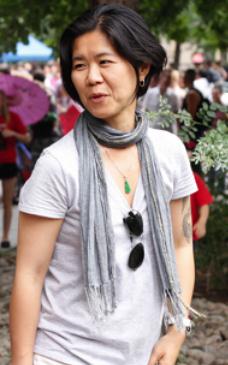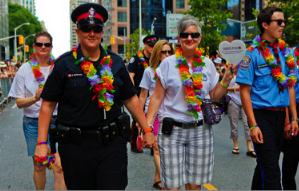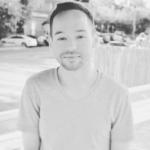
Kristyn Wong-Tam participates in the Trans March. Credit: Kyle Lasky
With an event the size of Pride Toronto, there are bound to be a few missteps on the journey to a successful event.
Yet according to Pride’s executive director, Kevin Beaulieu, and the city’s police force, there were no major issues this year.
Paramedics on stand-by along the parade route told Xtra a handful of people were treated for heat stroke and drunken falls.
“QuAIA was very peaceful,” Beaulieu says of the group Queers Against Israeli Apartheid, which was cleared to march in the parade only on June 29. “We do strive to provide a safe and secure and peaceful parade for everyone.”
When questioned about what he believes to be the most arresting aspects of this year’s party, Beaulieu says he enjoyed watching Lucas Silveira of The Cliks proposing to his girlfriend onstage in addition to family Pride.
Beaulieu went on to commend the organizers of the many die-ins, where participants lay still on the street for two minutes. Beaulieu says he believes die-ins were last part of Pride Toronto in 1994.
Constable Wendy Drummond, media relations officer for Toronto police, says she checked in with the 51 and 52 divisions and was pleasantly surprised to learn there were no significant issues over Pride weekend.
“I was very busy but, however, nothing significant to put a damper on the festival,” Drummond says.
Councillor Kristyn Wong-Tam noted that overall attendance by city councillors was down from 15 last year to 11 at this year’s festivities.
“There were a few folks who, for one reason or another, weren’t able to show up this year,” Wong-Tam explains. “That’s okay because many expressed regrets that they couldn’t be there and wished us a great parade. It’s the challenge of being on Canada Day weekend, and of course, there was Euro Cup.”
If the parade felt less corporate this year, Wong-Tam says, the credit goes to the community advisory panel (CAP) for making that strong message from the community clear to Pride Toronto.
“[CAP] said to Pride Toronto that certain things had to change, including the placement of locals. The political message must always be more prominent. The parade is a showcase for LGBT human rights; that should be the most important and dominant message. We welcome corporate sponsorship, but not at the sake of watering down or censoring any other message.”
Wong-Tam fondly recalls her emotional meeting with international grand marshal Goran Miletic, who spoke of Pride events in his native Serbia.
“When I spoke to Goran, one of the things that he said that was very striking for me, when I asked him how large the Pride event was in Belgrade, Serbia, he told me that 1,000 people come out to promote and celebrate Pride. It’s a political protest, and they do it in defiance of the 5,000 police officers that come out to monitor their activities and keep them safe from the 5,000 protesters. When he told me that was his political reality on a day-to-day basis, I was looking around and feeling so grateful to live in a country like Canada, feeling so blessed we have an institution like Pride that’s been around for 32 years.”
As long as our lesbian and gay brothers and sisters around the world live in fear of persecution and being killed, none of us are safe, she says.
“There’s a good reason why [Miletic] looked like he was on cloud nine.”
Beaulieu says he’s already anticipating another blemish-free celebration next year and thanked the tireless efforts of all the generous volunteers.
“I want to thank the LGBT community for all their support. Without them it doesn’t work; it doesn’t work without the 1,200 volunteers and the volunteers who work year-round to put it together. And I’m thrilled everyone had a good time, and I’m looking forward to doing it again next year and looking ahead to WorldPride 2014.”
— with files from Andrea Houston and Katie Toth
Check out our photos and video from Pride below.


 Why you can trust Xtra
Why you can trust Xtra


